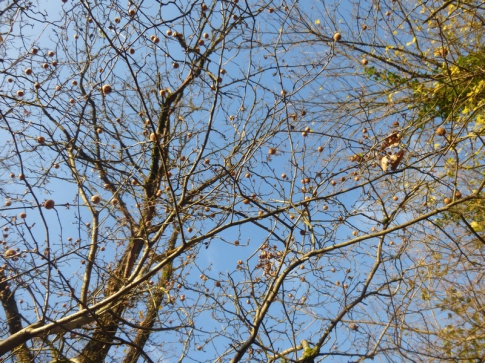News
2015-11-23
Harvesting medlar in Revin, Ardennes (F)
It's harvest time for medlar (Mespilus germanica). In French Ardennes, an impressive production of these fruits has recently been reported to us by a partner of the National Forestry Office (ONF). A few days later, we arrived on site with a team of 3 people to collect them.
Why Medlar?
Medlar is a particular specie, left aside in our forests, but with many interests. It deserves our full attention, and especially through a project such as the LIFE Elia-RTE !
Medlar is a relatively capricious specie for germination and breaking of dormancy. Dormancy is the temporary interuption of seeds' development (same for buds), during the winter period. Dormancy can end this interuption, in particular by using cold. The duration of the dormancy is different for each species. For medlar, it lasts over a period of 2 to 4 years. It is therefore necessary to have, especially for this specie, a long term vision.
Thus, with a view on the "after-LIFE" ensuring the sustainability of our actions after the end of the current project, we took the time now to harvest seeds such as those of the medlar, in order to be sure we can offer in the future of this secondary specie plants in sufficient quantity and proven to be from local origin.
The harvest in Revin
In the morning, the team has collected medlart fruits (called loquats) in Revin, where a population of at least 15-20 individuals bore lot of fruits this year. This site has been spotted by Michel Colcy from the ONF.

Fig.1.- Loquats in big quantity
Medlar trees were concentrated on a relatively small area, on a sunny south-facing slight slope. Setup like this one is a great opportunity to be fast and efficient. Appropriate management and concerns from local forest manager clearly contributed to maintain this medlar population.
Harvesting by shaking the tree, with a canvas sheet, worked very well for the ripest fruit. For the rest, they were simply picked directly from the tree or on the ground for those which have felt. In total, around 20kg of fruit were harvested on this site.

Fig.2.- Harvest of the fruits
Uses of medlar
It should be noted that fruits, relatively fleshy, particularly appeal birds such as thrushes and blackbirds, but also the game.
Medlar has a very slow growth and a very hard wood, homogeneous and dense (without excluding flexibility). It is use to craft good handles, typical Basque knives, tools, or canes. One of its typical uses of the Basque country is the production of renowned walking sticks, called Makilha. The size of these objects is obviously limited by the tortuous port and the small size of the tree in general. In addition to this, fruits can be consumed in various forms (jellies, jams, pies, wines, etc.).
For biodiversity, medlar tree provides shelter and food for birds, insects and micro-mammals. It is an essential host for our forest structured edges.

Fig.3.- Loquat on the ground (mixed with litter, it enables seeds to be exposed to humic acids from organic matter in decomposition and thus promote germination)
Fruit processing
In the afternoon, we went to the Forestier Counter of Marche-en-Famenne, owned and run by the Public Service of Wallonia. This institution is responsible for the harvesting of fruits from stands and seed orchards, extraction of the seed, dormancy and eventually resale to local nurseries. This is a key partner of our project for the actions of restoration and creation of forest structured edges, but also planting orchards of fruit tree species.
After weighing the harvest, the extraction itself is very simple. Just install the fruits between two riddles, which rests on a grating. It is best to stand above all to prevent riddles from moving. Then use a high-pressure water gun, such as karcher®, to pop the seed out of the fruit with the jet pressure (this works best if the fruits are already in an advanced state of maturity, or ideally overriped).

Fig.4.- Preparation of seeds for the extraction
Only the fruits from species whose seeds are highly resistant can undergo such treatment (medlar, hawthorn, blackthorn) otherwise seeds will be eventually damaged and unusable.


Fig.5.- Extraction of seeds with the karcher ®
Finally, we obtained a little less than 2 kg of seeds, moisted and non-sorted (presence of some remainings of various organic matter). The coming days were used to dry and sort these seeds using a densitometer, allowing us to know the exact weight of the seeds produced. This final weight will allow us to estimate the number of seeds since we know that 1 kg of seeds means around 6,000 to 8,000 seeds.
The seed counter will test different techniques to reduce the period of dormancy, especially by abrasion of the integument. This will provide us plants within 5 years, which will enrich the forests near Revin and power lines safety corridors managed by RTE.

